
3555
.pdf
Russian Journal of Building Construction and Architecture
References
1.Astakhov S. V. Vyvod formuly dlya progiba vneshne staticheski neopredelimoi ploskoi fermy pod deistviem nagruzki v seredine proleta [Derivation of a formula for the deflection of an externally statically indeterminate flat truss under load in the middle of a span]. Stroitel'stvo i arkhitektura, 2017, vol. 5, no. 2 (15), pp. 50—54.
2.Ignat'ev V. A. Raschet regulyarnykh sterzhnevykh sistem [The calculation of the regular rod systems]. Saratov, Saratovskoe vysshee voenno-khimicheskoe voennoe uchilishche, 1973. 433 p.
3.Kirsanov M. N., Moskvin V. G. Deformatsii ploskoi fermy s usilennoi reshetkoi [Deformation of flat farm with reinforced bars]. Stroitel'naya mekhanika i raschet sooruzhenii, 2018, no. 4 (279), pp. 10—14.
4.Kirsanov, M. N. Montazhnaya skhema reshetchatoi fermy s proizvol'nym chislom panelei [Wiring diagram of a lattice truss with an arbitrary number of panels]. Inzhenerno-stroitel'nyi zhurnal, 2018, no. 5 (81), pp. 174—
182.doi: 10.18720/MCE.81.17.
5.Osadchenko, N. V. Analiticheskie resheniya zadach o progibe ploskikh ferm arochnogo tipa [Analytical solutions of the problems of deflection of plane trusses of arch type]. Stroitel'naya mekhanika i konstruktsii, 2018, vol. 1, no. 16, pp. 12—33.
6.Osadchenko N. V. Raschet progiba ploskoi nerazreznoi staticheski opredelimoi fermy s dvumya proletami
[Calculation of deflection of a flat continuous statically defined truss with two spans]. Postulat, 2017,
no. 12 (26), p. 28.
7. Shalukhin V. D. Perspektivnye razrabotki v sistemakh naruzhnogo osveshcheniya [Promising developments in outdoor lighting systems]. Nauchno-obrazovatel'nyi potentsial molodezhi v reshenii aktual'nykh problem XXI veka, 2016, no. 4, pp. 248—251.
8.Arabi S., Shafei B., Phares B. M. Fatigue Analysis of Sign-Support Structures During Transportation Under Road-Induced Excitations. Engineering Structures, 2018, vol. 164, pp. 305—315. doi: https://doi.org/ 10.1016/j.engstruct.2018.02.031.
9.Belyankin N. A., Boyko A. Y. Analysis of the Deflection of the Flat Statically Determinate Girder. Nauchnyi Al'manakh, 2017, no. 2—3 (28), pp. 246—249.
10.Chen G., Wu J., Yu J., Dharani L., Barker M. Fatigue Assessment of Traffic Signal Mast Arms Based on Field Test Data Under Natural Wind Gusts. Transportation Research Record Journal of the Transportation Research Board, 2001, no. 1770, pp. 188—194. doi: http://dx.doi.org/10.3141/1770-24.
11.Hutchinson R. G., Fleck N. A. Microarchitectured Cellular Solids — the Hunt for Statically Determinate Periodic Trusses. Journal of Applied Mathematics and Mechanics, 2005, vol. 85, no. 9, pp. 607—617.
12.Hutchinson R. G., Fleck N. A. The Structural Performance of the Periodic Truss. Journal of the Mechanics and Physics of Solids, 2006, vol. 54, no. 4, pp. 756—782.
13.Kacin J., Rizzo P., Tajari M. Fatigue Analysis of Overhead Sign Support Structures. Engineering Structures, 2010, no. 32, pp. 1659—1670. doi: http://dx.doi.org/10.1016/j.engstruct.2010.02.014.
14.Kirsanov M. N. Parallelogram Mechanism with Any Number of Sections. Russian Engineering Research, 2018, vol. 38, iss. 4, pp. 268—271. doi: https://doi.org/10.3103/S1068798X18040135.
15.Kirsanov M. N. A Precise Solution of the Task of a Bend in a Lattice Girder with a Random Number of Panels. Russian Journal of Building Construction and Architecture, 2018, no. 1 (37), pp. 92—99.
70
Issue № 2 (42), 2019 |
ISSN 2542-0526 |
16.Kirsanov M. N., Tinkov D. V. Analytical Calculation of the Deflection of the Lattice Truss. MATEC Web of Conferences, 2015, vol. 193, 03015. doi: https://doi.org/10.1051/matecconf/201819303015.
17.Rakhmatulina A. R., Smirnova A. A. The Formula for the Deflection of a Truss Loaded at Half-Span by a Uniform Load. Postulat, 2018, no. 3. Available at: http://e-postulat.ru/index.php/Postulat/article/download/ 1293/1324.
18.Rakhmatulina A. R., Smirnova A. A. Two-Parameter Derivation of the Formula for Deflection of the Console Truss. Postulat, 2018, no. 5. Available at: http://e-postulat.ru/index.php/Postulat/article/download/ 1456/1487.
19.Rice J. A., Foutch D. A., La Fave J. M., Valdovinos S. Field Testing and Analysis of Aluminum Highway Sign Trusses. Engineering Structures, 2012, no. 34, pp. 173—186. doi: http://dx.doi.org/10.1016/j.engstruct.2011.09.021.
20.Tinkov D. V., Safonov A. A. Design Optimization of Truss Bridge Structures of Composite Materials. Journal of MachineryManufacture and Reliability, 2017, vol. 46, no. 1, pp. 46—52.
21.Rakhmatulina A. R., Smirnova A. A. The Dependence of the Deflection of the Arched Truss Loaded on the Upper Belt, on the Number of Panels. Nauchnyi Al'manakh, 2017, no. 2—3 (28), pp. 268—271.
71

Russian Journal of Building Construction and Architecture
CITY PLANNING, PLANNING OF VILLAGE SETTLEMENTS
DOI 10.25987/VSTU.2019.42.2.008
UDC 711.4
D. Dopudja1, I. Rakonjac2, N. Gadzic3
PECULIAR PROPERTIES AND POSSIBLE WAYS OF IMPROVEMENT
OF CURRENT FOURFOLD VILLAGE SETTLEMENTS CLASSIFICATIONS
IN REPUBLIC OF SERBIA
Republic of Serbia, Belgrade,
tel.: +7(965)264-02-12, e-mail: dusan.dopudja@yandex.ru
1M. Arch, Independent Architect
University of Belgrade
Republic of Serbia, Belgrade, tel.: +381-65-321-79-96, e-mail: i.rakonjac@gmail.com
2PhD in Architecture, Assistant Professor, Faculty of Architecture, Dept. of Architecture
University of Prishtina
Republic of Serbia, Kosovska Mitrovica, tel.: +381-63-8867-38-76, e-mail: nebojsa.gadzic@pr.ac.rs
3PhD in Architecture, Teaching Assistant, Faculty of Technical Sciences, Dept. of Architecture
Statement of the problem. At the current moment, a system of typological classification of village settlements in Republic of Serbia is made out of four independent classifications, which are only looselytied toeach other. These classifications are based on: the way ofsettlements’ occurrence, settlements’ urban-morphological features, itssize, anditsfunction insidea broader set ofsettlements.
Results. Summed up, the results of all four typologies create an abundance of input information for a later process of urban planning and design: theymake it sluggish, and so, uneasyto handle. This is especially noticeable in large-scale spatial planning, which strongly relies on spatial diagrams, so it is in the need of concentrated information. Having in mind all aforementioned, the authors took the liberty to try to optimize the current fourfold classification system. The optimization was done through checking the output data relevance in context of modern urban planning and design workflows, and assuring, that there is no overlapping information.
Conclusions As a result, a brand new, purified and optimized village settlement classification was proposed, along with short demonstration of its practical use.
Key words: rural, settlement, morphology, typology, classification, border, planning, design, Serbia
Introduction. The main characteristic of built environments’ urban development in Republic of Serbia (RS), regardless of whether it is an urban or rural area, is discontinuity of its development. It is due to the dynamic history of Balkan Peninsula, that a tremendous amount of Serbia’s village settlements was occasionally destroyed (completely or partially), deserted, again colonized, or simply moved to another place.
© Dopudja D., Rakonjac I., Gadzic N., 2019
72

Issue № 2 (42), 2019 |
ISSN 2542-0526 |
This peculiar situation has spawned an abundance of village settlements whose properties are often very difficult to properly identify and define, not to speak of matters of their typologization. For this reason, there is a current professional practice among architects and urban planners in Republic of Serbia to analyze their subject (or subjects) from four different points of view, in order to properly classify it1. Each of those points of view represents, in fact, an independent classification –– which clearly leads to an informational overload.
Although there is no question, whether plethora of information is better than lack of it, if we take into consideration a time constraint of a design process, too (which has always been an extremely important and unavoidable factor) –– there rises a question: is there a way to systematize typologyofSerbian village settlements inanother, simpler way, without reducing its’quality?
1. Current state of affairs. In order to find an answer to the above-given question, in this paper we will show all four currently used classifications with brief explanations, expose their strengths and weaknesses, and try to offer a possible pathway for a solution of this, often handicapping, professional practice. Classification methods are following:
1)Classification by way of settlements’ occurrence;
2)Classification in accordance to settlements urban-morphological criteria;
3)Classification by settlement size (purely demographical characteristic);
4)Classification by settlement function (inside a broader settlement system2) [13, 17, 18]. According to the first classification method, the one based on the way of settlements occurrence (Classification 1), villages in Republic of Serbia can be divided into three groups:
1)Systematically developed (planned) settlements;
2)Subsequently re-planned settlements, and;
3)Spontaneously formed settlements. [13, 17] (Fig 1, 2).
Systematically formed settlements are, with handful of exceptions, always located north of the rivers Sava and Danube (Autonomous Province of Vojvodina, or APV), and were formed by a direct intervention of the authorities (Austro-Hungarian planification of Vojvodina in the 18th
century)3. During that process, existing, spontaneously formed and freely-planned settlements were de-settled, and subsequently destroyed. In current moment, beside systematically formed, there absolutely no other village types on the territory of APV4.
1Usuallyas a preface for making planning documents or landscape development projects.
2Russian: “a settlement system”.
3For better understanding, it is very important to mention that territory of Vojvodina was part of the Austrian Empire (later Austria-Hungarian Empire) from 15th to 20th century, with a brief period of Ottoman reign in 17th century. Hence its Central-European attributes in architecture and town-planning.
4Not counting weekend suburban colonies. Russian “dacha (summer house) settlements”).
73
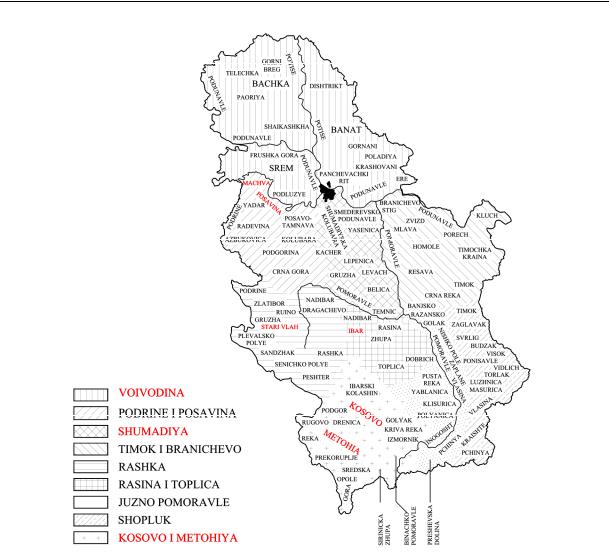
Russian Journal of Building Construction and Architecture
Fig. 1. Geographical entities in Republic of Serbia. Those, mentioned in text, are dyed in red
Spontaneously formed settlements, on the other hand, are located exclusively south of the mentioned rivers (Serbia Proper and the Autonomous Province of Kosovo and Metohija). They are most numerous of all, and to this day they in a great amount follow their ancient structure and street matrix.
Subsequently re-planned settlements represent a transitional form, from the spontaneously formed villages to the systematically planned ones. They owe their current urban grid to the efforts of 19th century Serbian authorities to model villages in Serbia Proper (mostly flatland regions of Machva and Posavina, as they are geographically most similar to Vojvodina) according to those in neighboring Austro-Hungary. In other words, the urban tissue of subsequently re-planned settlements was created spontaneously, but in certain period of time, due to the influence of an external factor, it endured so many significant changes, that its characteristics do not fit any of the aforementioned groups any more.
74
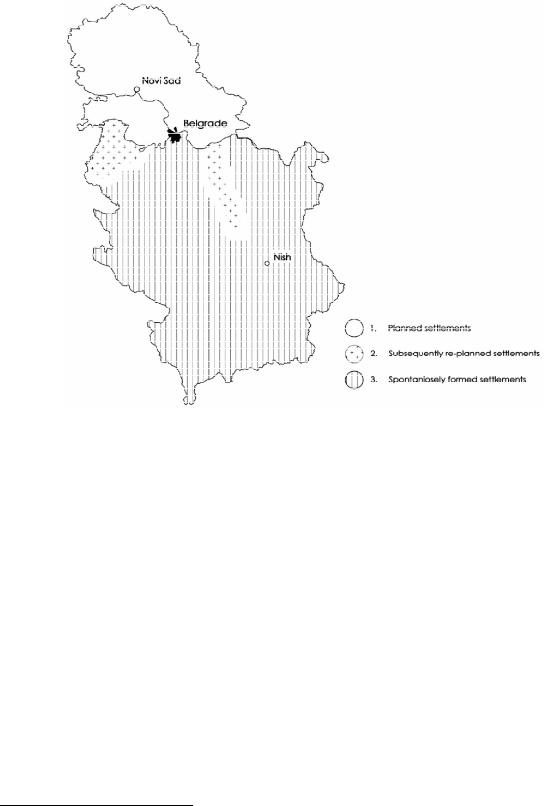
Issue № 2 (42), 2019 |
ISSN 2542-0526 |
Fig. 2. Spatial distribution of village types, according to their wayof occurrence [13]
Typology by urban-morphological characteristics is based on the analysis of built environments’ basic elements. Without them, it is not possible to properly understand any settlement, rural or urban. Since urban morphology represents a “scientific discipline that deals with the study of genesis and further development of the form of built structures and open spaces, in urban environment” [8], classification by this method has an extremely important role in further spatial development of a village5.
The reason for this statement lies primarily in the fact that, by tracking the development of the settlement over time, it is possible to identify a pattern which is aforementioned process following, and to adequately direct it in a desired direction [1]. The main criteria for classification of settlements by this typology are:
––The possibility or impossibility to determine settlements’ boundaries6;
––Street matrix;
5Morphology, as a form of research, represents an integral part of many scientific disciplines, and is used as a method, explaining phenomena and processes related to creation of specific shapes and forms. The essential characteristics of all morphological investigations are studying the principle of common shapes and structures, and establishing common morphological characteristic of the elements (comparative analysis) [1].
6Bythis, we speak of distinguishing of housing and agricultural lands.
75
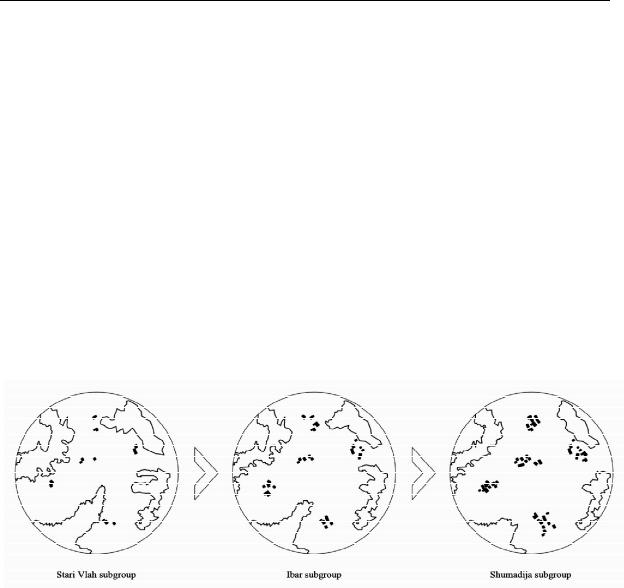
Russian Journal of Building Construction and Architecture
––The gross density of the settlements’ built environment;
––Lots’ (households’) size and shape, and in some cases, distances between them;
––Building patterns [8, 13, 17].
In accordance with aforementioned criteria, village settlements can be classified in two basic types: settlements with compact structure, and the ones with dispersed one.
Settlements with dispersed structure are divided into three sub-groups, each of them named after the geographical region in which it arose. These are Stari Vlah, Ibar, and Shumadiya subgroups. As we are able to see in (Fig. 3), they in fact represent three development levels of the same settlement type. Their main characteristic is that there is no way to pinpoint an exact location of a settlement, or even a village center, because households are scattered across a wide area. Sometimes, distance between them can be up to 2000 m. Also, there is one regularity: all dispersed villagesare located southofthe Sava and Danube rivers, and were formed spontaneously.
Fig. 3. Spatial evolution of dispersed structure village settlements, from Stari-Vlah settlement,
trough Ibar subgroup, to Shumadija-type village
Villages with compact structure have two subgroups: semi-compact and completely compact village settlements. Semi-compact villages are settlements with a medium population density of 20––25 p/ha, most often with duly formed household lots. They include: systematically developed (Voivodina), subsequently re-planned (Machva, Posavina), and spontaneously formed villages in the Velika Morava river valley (which are characterized by an irregular street network and household form).
Completely compact settlements, on the other hand, represent a characteristic of eastern and southern parts of Serbia Proper, together with Kosovo and Metohiya province. There are three basic subtypes: dispersed settlement (arose as a result of satellite-type development of exis-
76
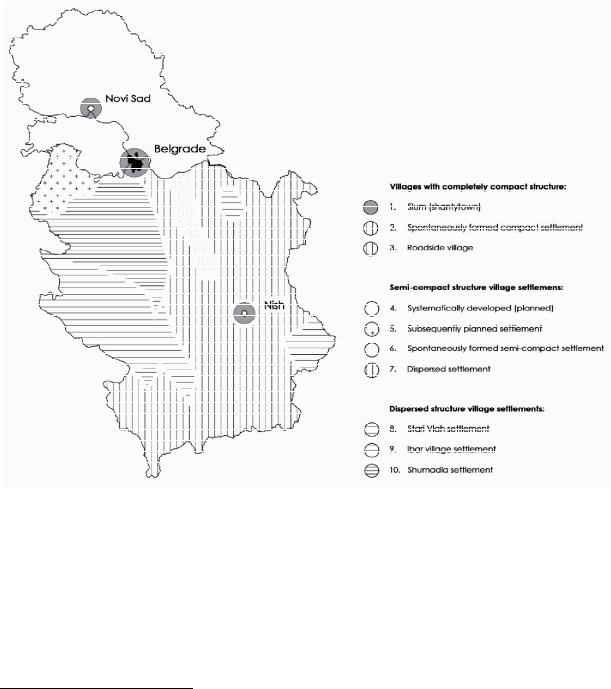
Issue № 2 (42), 2019 |
ISSN 2542-0526 |
ting villages dye to overpopulation; they are characterized by central urban area and several hamlets7), roadside settlements (prominently longitudinal and established along the dominant communication), and plain spontaneously formed villages with compact structure. In addition, during last few decades, we are witnessing a rising of another village type: slums8 –– formed due to large migration flows to the biggest urban centers (Fig. 4).
Fig. 4. Spatial distribution of village types, according urban-morphological classification
In typology by settlement size, the number of inhabitants represents a major criterion. Therefore, according to it, village settlements of Serbia are sorted into:
–– Small settlements:
o 0––100 residents –– M1; o 100––500 residents –– M2;
7Hamlet is a small human settlement. Usually, it is a subdivision of a village, his satellite entity. Is equivalent to Serbian noun «заселак», or Russian «хутор».
8Also known as “shantytowns”.
77

Russian Journal of Building Construction and Architecture
–– Medium settlements:
o 500––1000 residents –– C1; o 1000 –– 2000 residents –– C2; –– Large settlements:
o 2000––3000 residents –– B1;
o More than 3000 residents –– B2 [13, 17]9.
Although, since settlement size represents a changing category, we are ought to take into consideration data about the settlement demographics, too. So, if the population index between two censuses (usually done in a 10-year span) is greater than 100 %, the settlement has a positive demographic development. If it is between 80 and 100 %, the development stagnates, and if it is lower than 80 % –– the development is negative.
As for the spatial distribution, the largest villages are located in the plain or gently rolling terrain of Vojvodina, Machva and Posavina (mostly C2 and B1), while the smallest ones are scattered exclusively in the inaccessible mountainous areas in the south and south-west areas of Republic of Serbia (M1, M2). On the other hand, the demographic trends do not depend only of a landscape, but from a multitude of interdisciplinary factors. Hence, the villages with positive demographic development are mostly spread around the strong economical centers: capital Belgrade, and cities Novi-Sad and Nish [8].
In categorization by a settlement function, the core criterion is a role of the village in broader set of settlements. That role can be primary or special. Villages with primary functions are divided into:
––Primary villages, which do not have any other function beside agriculture;
––Villages with village centers, which, in addition to the core activity – agriculture, also possess certain additional features, embodied trough school, police station, local office, health center, post office, grocery store, etc.;
––Centers of the village settlements set, which, compared to the previous type, have more developed additional functions (primary and secondary school, church, shops, café), but the primary activity of the population is still agriculture10 [17] (Fig. 5).
9Code explonation: „M“ is derived from the Serbian word ’’мали“ (eng. – “little”, рус. – „маленький“), „C“ from the word „средњи“ (eng. – “medium”, рус. – „средный“), and „B“ from the word „велики“ (eng. – “big”,
рус. – „большой“).
10They possess notable differences, depending if the settlement is located in Eastern or Western part of Serbia, as theydeveloped under the influence of two separate cultures: Slavic (West Serbia) or Oriental (East Serbia).
78
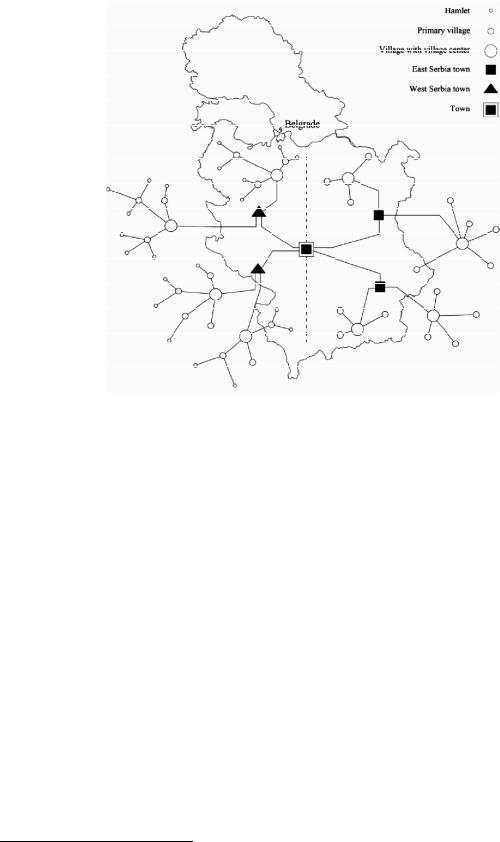
Issue № 2 (42), 2019 |
ISSN 2542-0526 |
Fig. 5. Functional connections of villages in broader settlement set: scheme for East and West Serbia.
Made according to map from [17]
Special village settlements are settlements formed around natural sanatoriums, hotels, hospitals, hunting and fishing areas, etc. Their dwellers profession does not refer to agriculture, and they are not necessary for the functioning of a wider settlement network. Also, due to features of the complexes around which they are formed, they are often only temporarily inhabited11.
2. Optimization of classification methods. Having in mind all the information presented above, the simplest and most common solution would be to merge all four classifications into one. However, does it make any sense in this particular situation? If we do the calculation, we will see that that would produce more than2000 different village types, which is clearlyout ofconsideration12. So, in order to narrow down number of possibilities as much as possible, we are ought to make a more profound analysis of two situation aspects:
––Mutual relations between the information that the concrete classification provides and the process of urban design;
––Actual relevance of the particular classification itself.
11Especially nowadays, when the transportation and transportation links are greatlyimproved.
123 × 10 × 6 × 12 = 2160 – simplified mathematical calculation, without taking into account relations between some types and subtypes (for example, no dispersed structure settlement is systematicallydeveloped).
79
